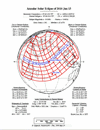- - text and links as of last publication - -
![]()
| CAUTION! OBSERVING A SUN ECLIPSE IS DANGEROUS AND MAY CAUSE IRREVERSIBLE EYE DAMAGE, UP TO BLINDNESS, ANNULAR AND PARTIAL ECLIPSES INCLUDED! Observing a Sun eclipse necessitates DEDICATED SAFE TECHNIQUES! |
The January 15th, 2010 annular solar eclipse -the first solar eclipse of the year- is an annular eclipse, running from Central Africa to China! An annular eclipse is occurring when the apparent diameter of the Moon is smaller than the one of the Sun, due to the general geometry of the eclipse. During a annular solar eclipse, a ring of Sun is still visible, surrounding the dark disk of the Moon, as it doesn't provide the observers with the more classical view of the Sun totally hidden and of the corona streaming away. During a annular eclipse, the 'umbra', the shadow yielded trough the eclipse is reaching the Earth nowhere, as it's, at the opposite, the 'antumbra' which does, a lesser kind of shadow. for more about the solar eclipses, theoretically, see our tutorial "Sun Eclipses"
The path of the January 15th, 2010 annular solar eclipse is running a long way from about eastern Cameroon to the northeastern coast of China! The greatest of the eclipse is reached over the ocean only, somewhere West of the Maldives, by 07:06:25 UT. The eclipse thus is running through eastern Cameroon, C.A.R., northern Democratic Republic of the Congo, Uganda, Kenya, southern Somalia as it crosses then the Arabian Sea. It reaches land back over the South of India and northern Sri Lanka and then crossing the Bay of Bengal. The eclipse reaches lands again by Burma and eastern India and thence crossing China until the Gulf of Po Hai. The show is beginning by about 8:00 a.m. local time in eastern Cameroon, as it is ending by 3:00 p.m. local time in China. The width of the eclipse's path is of 207 miles (333 km) as the eclipse is lasting 11 mn and 7 seconds. Like the case for any annular -or total eclipse- a partial eclipse is available either side of the path where the eclipse is seen annular. The far reaches of those regions with a partial eclipse are from Ukraine and South Africa to Russian Siberia, Indonesia and the Philippines. The closer the path of the annular eclipse, the larger the partial!
 |  |  |  | Views of the January 15th, 2010 annular solar eclipse as it will appear at its greatest (left) or as seen like a partial in Amman, Jordan, Manila, Phillipines, or Bombay, India (following pictures, from left to right, respectively). pictures site 'Amateur Astronomy', based on Celestia (picture left) and Cartes du Ciel (other pictures) |
The eclipse's main data are the following (data as of May 1999, F. Espenak, NASA/GSFC). The Moon's apparent diameter will be of 29' 28.6", compared to the Sun's 32' 31". for more about how to observe a solar eclipse, see our tutorial "Observing a Sun Eclipse ":
- greatest eclipse: 07:06:25.6 UT
- eclipse magnitude (fraction of the Sun's diameter obscured by the Moon at greatest eclipse): 0.9190
- local circumstances at greatest eclipse (lat: 01° 37.3'N, long: 069° 19.6'E, elev of Sun: 66.4°; duration at greatest: 11m 07.7s)
- U1 to U4 (moments of first-last external-internal tangency of the antumbra with Earth's limb; practically these are the moments of the eclipse for the places where the eclipse is annular); in UT: U1 at 05:13:47.7, U2 at 05:21:08.7, U3 at 08:51:32.6, U4 at 08:58:56.0
- P1 to P4 (moments of first-last external-internal tangency of the penumbra with Earth's limb; practically these are the moments of the eclipse for the places where the eclipse is partial), in UT: P1 at 04:05:20.1, P2 at 06:49:58.2, P3 at 07:22:31.3, P4 at 10:07:27.5
 | see a map for the January 15th, 2010 annular solar eclipse. map courtesy Fred Espenak - NASA/GSFC, as reproduced in Cartes du Ciel, Patrick Chevalley |
. for more about this eclipse and for more about solar and lunar eclipses generally, you may see at, for example, Fred Espenak's NASA Eclipse Web Site
Observation Reports: the eclipse was the object of a series of sounding rockets launched by India at the effect of studying the effect of the eclipse over the upper atmosphere of the Earth. That eclipse was supposed to be the longest of the 21st century
Website Manager: G. Guichard, site 'Amateur Astronomy,' http://stars5.6te.net. Page Editor: G. Guichard. last edited: 12/28/2010. contact us at ggwebsites@outlook.com